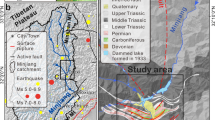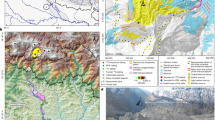Abstract
On November 28, 2003, at about 00:30 PST, 35 km east of Prince Rupert in northwestern British Columbia, an extremely rapid, retrogressive liquefaction earth flow, or a clay flow-slide, severed the natural gas pipeline. As a result, Prince Rupert residents were without natural gas heat for 10 days. The landslide has a steep main scarp that is 45 m high by 345 m wide. It consists of glaciomarine sediments mantled by rubbly colluvium lying on, and against smooth bedrock of the valley wall. It covers an area of 32 ha, and displaced about 4.7 M m3 of material. This displaced material flowed up and down river over a distance of 1.7 km, blocked the river, and caused flooding upstream for a distance of 10 km. This landslide is the most recent of four large landslides that have occurred over the last four decades in glaciomarine sediments in northwestern British Columbia.







Similar content being viewed by others
References
Abbott RT (1974) American Seashells: The marine mollusca of the Atlantic and Pacific Coasts of North America. Van Nostrand Reinhold Company, New York, 663 pp
Banner A, MacKenzie W, Haeussler S, Thomson S, Pojar J, Trowbridge R (1993) A field guide to site identification and interpretation for the Prince Rupert Forest Region. Land Management Handbook. No. 26, Part 1, British Columbia Ministry of Forests, 405 pp
Clague JJ (1978) Terrain hazards in the Skeena and Kitimat River Basins, British Columbia. Current Research, Part A, Geological Survey of Canada, Paper 78–1A, pp 183–188
Clague JJ (1984) Quaternary geology and geomorphology, Smithers-Terrace-Prince Rupert area, British Columbia. Geological Survey of Canada Memoir 413, 71 pp
Cruden DM, Varnes DJ (1996) Landslide types and processes. In: Turner AK, Shuster RL, (eds) Landslides investigation and mitigation, Special Report 247, Transportation Research Board, National Research Council, Washington DC, pp 36–75
Duffel S, Souther JG (1964) Geology of the Terrace map-area, British Columbia (103 I E 1/2). Geological Survey of Canada Memoir 329, 117 pp
Dyke AS, Dale JE, McNeely RN (1996) Marine molluscs as indicators of environmental changes in glaciated North America and Greenland during the last 18,000 years. Géographie Physique et Quaternaire, 50:125–184
Geertsema M (1998) Flowslides in waterlain muds of northwestern British Columbia, Canada. In: Proceedings of the 8th Congress of the International Association of Engineering Geology and the Environment, Vancouver, Volume III, pp 1,913–1,921
Geertsema M, Schwab JW (1995) The Mink Creek earthflow, Terrace, British Columbia. In: Proceedings of the 48th Canadian Geotechnical Conference, Vancouver, pp 625–633
Geertsema M, Schwab JW (1997) Retrogressive flowslides in the Terrace-Kitimat, British Columbia area: from early post-deglaciation to present and implications for future slides. In: Proceedings of the 11th Vancouver Geotechnical Society Symposium, pp. 115–133
Geertsema M, Cruden DM, Schwab JW (2003) Style and sequence of movement in a landslide in sensitive glaciomarine sediments at Mink Creek, near Terrace, British Columbia. In: Proceedings of the 3rd Canadian Conference on Geotechnique and Natural Hazards, Edmonton, pp 178–185
Holland SS (1976) Landforms of British Columbia. British Columbia Department of Mines and Petroleum Resources, Bulletin 48, 138 pp
Hungr O, Evans SG, Bovis M, Hutchinson JN (2001) Review of the classification of landslides of the flow type. Environmental and Engineering Geoscience 7:221–238
Hutchison WW, (1982) Geology of the Prince Rupert-Skeena Map area, British Columbia. Geological Survey of Canada Memoir 394, 116 pp
Lebuis JJ, Robert M, Rissmann P (1983) Regional mapping of landslide hazard in Quebec. In: Bergren B, Lindgren J (eds) Symposium on slopes on soft clays, Swedish Geotechnical Institute Report No. 17, Linköping, pp 205–262
Mitchell RJ, and Markell AR (1974) Flowing in sensitive soils. Canadian Geotechnical Journal 11:11–31
Quigley RM (1980) Geology, mineralogy, and geochemistry of Canadian soft soils: a geotechnical perspective. Canadian Geotechnical Journal 17:261–285
Viberg L (1983) Experiences of mapping and classification of stability conditions. In: Bergren B, Lindgren J (eds) Symposium on slopes on soft clays, Swedish Geotechnical Institute Report No. 17, Linköping, pp 455–461
Acknowledgments
We thank Drs. O. Hungr and B. Pelletier for the helpful suggestions, which improved the manuscript; Dr. A. Dyke for help in identifying the molluscs; M. Wygergangs and J. Brennan for sample preparation; Dr. D. Mosher, O. Brown and K. McKillop for sediment analyses; and R. Franklin for drafting.
Author information
Authors and Affiliations
Corresponding author
Rights and permissions
About this article
Cite this article
Schwab, J.W., Geertsema, M. & Blais-Stevens, A. The Khyex River landslide of November 28, 2003, Prince Rupert British Columbia Canada. Landslides 1, 243–246 (2004). https://doi.org/10.1007/s10346-004-0026-0
Received:
Accepted:
Published:
Issue Date:
DOI: https://doi.org/10.1007/s10346-004-0026-0




